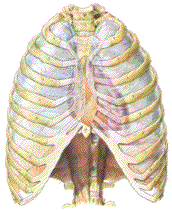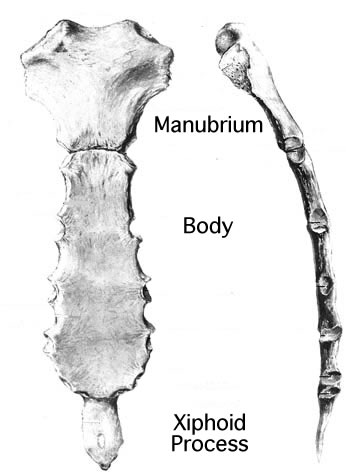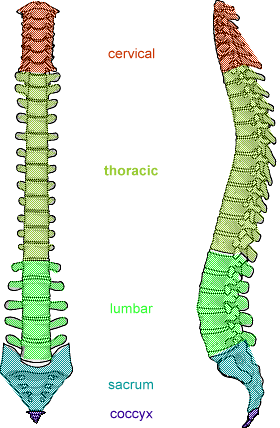The Ribs
The ribs protect the vital organs of the torso, particularly the heart and lungs, by wrapping around from the thoracic vertebrae of the spine in the back to the sternum in the front.
 There are three types of ribs:
There are three types of ribs:
- Seven ribs which connect directly to the sternum (1-7)
- Three ribs which connect to the costal cartilages of the rib above (8-10)
- Two "floating" ribs which connect only at the back (11&12)
The Sternum
The sternum has three parts: the manubrium, the body and the xiphoid process.

- the manubrium - is connected to the collarbones and can be felt at the top of the chest. It also is connected to the first rib
- the body of the sternum - the main breastbone which shields the organs of the torso, and is connected directly to ribs2 - 7, and indirectly to ribs 8 - 10.
- the xiphoid process - a thin, blade-like portion, at the bottom
The side view in the image above allows you to see the notches where the costal cartilages connect the ribs to the body of the sternum. You may be able to feel these bumps, where the bone and cartilage connect, by running a finger up and down the edge of your sternum.
 The cartilaginous connection allows the ribcase a degree of flexibility. In the old "rib-reserve" theory of singing and speaking, the ribs were held "up", and all the breathing was done abdominally. This lead to very stiffly held ribcages, and sternii that were rigidly held in place. In more recent developments of voice training, students are encouraged to keep the sternum "soft", allowing the sternal joints to be as flexible, and relaxed as possible.
The cartilaginous connection allows the ribcase a degree of flexibility. In the old "rib-reserve" theory of singing and speaking, the ribs were held "up", and all the breathing was done abdominally. This lead to very stiffly held ribcages, and sternii that were rigidly held in place. In more recent developments of voice training, students are encouraged to keep the sternum "soft", allowing the sternal joints to be as flexible, and relaxed as possible.The image at the right shows the sternum of an eleven year old - the bone of the sternum has yet to "ossify" completely. You can see how the bone develops from the centres of ossification and spreads outwards. These centres develop before the child is born, but don't completely ossify until the mid-teens. The sternal cartilages begin to ossify as the adult reaches older age as blood flow is very minimal.
The Spine

The Spine has five major sections
- Cervical - the top seven vertebrae which make up the neck
- Thoracic - the twelve vertebrae connected to the ribs
- Lumbar - the heaviest five vertebrae which support the torso
- Sacrum - a large, dish-like bone, made up of the sacral vertebrae, which have fused solidly together to make up the connection of the spine to the pelvis
- Coccyx - the vestigial tailbone is made up of 3 to 4 fused vertebrae
No comments:
Post a Comment